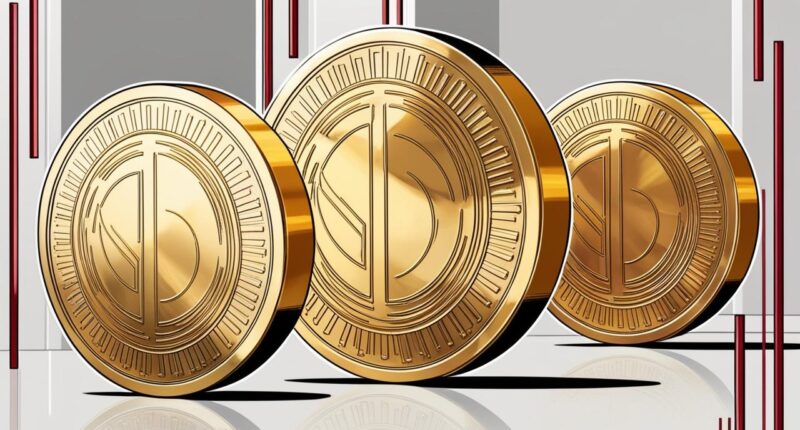Stablecoins are digital currencies designed to maintain a stable value by pegging them to reserve assets, such as fiat currencies, cryptocurrencies, or commodities. They serve various purposes, including facilitating transactions on exchanges, aiding cross-border payments, and supporting decentralized finance applications. Mechanisms like collateralization and regular audits help guarantee their stability. Despite challenges like regulatory scrutiny and market pressures, stablecoins play an essential role in enhancing financial inclusion and efficiency. More insights await on their workings and applications.
Stablecoins represent a significant innovation in the cryptocurrency space, designed to provide a stable alternative to the inherent volatility of traditional cryptocurrencies. They achieve this stability through various mechanisms, which can be broadly categorized into multiple types.
Fiat-collateralized stablecoins, for example, are backed by traditional currencies like the US dollar, guaranteeing a 1:1 peg. In contrast, crypto-collateralized stablecoins are backed by other cryptocurrencies, often requiring over-collateralization to maintain their value. Commodity-backed stablecoins peg their value to physical assets such as gold or oil, while algorithmic stablecoins utilize smart contracts to adjust supply dynamically, aiming to keep their value stable. Some stablecoins may also combine these methods, forming hybrid models.
Stablecoins come in various forms, including fiat-collateralized, crypto-collateralized, commodity-backed, and algorithmic models, each designed to maintain stability.
To uphold their peg, stablecoins utilize reserve assets held as collateral, which are subjected to regular audits to promote transparency. For crypto-collateralized coins, over-collateralization adds an extra layer of security. Arbitrage opportunities can also arise, allowing traders to exploit price differences, which helps stabilize the coin’s value. Additionally, stablecoins are increasingly used for cross-border payments, making them appealing for international transactions. As a result, stablecoins contribute to financial inclusion by providing accessible payment solutions for unbanked populations.
Notable examples of stablecoins include Tether (USDT), the largest by market capitalization; USD Coin (USDC), which is fully backed by the US dollar; and Dai (DAI), a decentralized option. Binance USD (BUSD) and the now-collapsed TerraUSD (UST) are also significant players in the market.
Stablecoins serve various purposes, such as acting as trading pairs on cryptocurrency exchanges, facilitating cross-border payments, and enabling operations within decentralized finance (DeFi) applications.
Despite their advantages, which include reduced volatility and faster transactions, stablecoins face regulatory concerns. Issues such as transparency in reserves, potential financial risks, and consumer protection are under scrutiny. Challenges like maintaining a 1:1 peg during market stress and centralization risks for fiat-backed coins also pose complications.
Frequently Asked Questions
Are Stablecoins Regulated by Any Government Authorities?
Stablecoins are subject to regulation by various government authorities, though no thorough federal framework exists in the U.S.
State regulators oversee their issuance and custody under money transmission laws. The SEC and CFTC have claimed authority over certain stablecoins, with international bodies also proposing regulations.
In the U.S., proposed legislation, like the GENIUS Act, aims to establish licensing requirements and consumer protections, further shaping the regulatory landscape for stablecoins.
What Are the Risks Associated With Using Stablecoins?
The risks associated with using stablecoins include market and liquidity vulnerabilities, which can lead to destabilization during high redemption demand.
Operational and security issues arise from unregulated issuers, increasing susceptibility to cyber-attacks and fraud. Financial stability is threatened by potential disruptions in funding markets and risks to banks holding stablecoin deposits.
Additionally, regulatory challenges exist due to incomplete frameworks, posing risks related to money laundering and tax evasion, complicating compliance across jurisdictions.
How Can I Buy and Sell Stablecoins?
To buy and sell stablecoins, one must first choose a cryptocurrency exchange, ensuring it offers the desired stablecoins and has reliable security features.
After creating an account and completing identity verification, users can fund their account.
To buy, select the stablecoin and trading pair, then confirm the transaction.
Selling involves selecting the stablecoin from the wallet, choosing the trading pair, entering the amount, and confirming the sale to receive funds.
Do Stablecoins Earn Interest Like Traditional Savings Accounts?
Stablecoins can earn interest similarly to traditional savings accounts, often through various platforms.
Interest rates typically range from 1% to over 10% APY, depending on the platform and conditions. Users can deposit stablecoins into lending platforms, engage in staking on exchanges, or participate in decentralized finance (DeFi) protocols.
However, risks exist, such as potential hacks and regulatory uncertainties, which should be considered before earning interest on stablecoins.
Can Stablecoins Be Converted to Fiat Currency Easily?
Stablecoins can be converted to fiat currency, but the ease of conversion varies by method and platform.
Users often utilize cryptocurrency exchanges, which may require KYC verification and impose minimum withdrawal amounts. Fees usually range from 0.1% to 3%.
Peer-to-peer platforms and direct redemptions from stablecoin issuers are alternatives. However, regulatory considerations, market liquidity, and bank partnerships can complicate the process, leading to longer processing times and varying conversion rates.
References
- https://www.gemini.com/cryptopedia/what-are-stablecoins-how-do-they-work
- https://www.muralpay.com/blog/what-is-a-stablecoin
- https://www.moonpay.com/learn/cryptocurrency/what-are-stablecoins
- https://www.chainalysis.com/blog/stablecoins-most-popular-asset/
- https://www.bankrate.com/investing/stablecoin-cryptocurrency/
- https://hedera.com/learning/tokens/what-is-a-stablecoin
- https://world.org/articles/scroll-through-worldcoin-beginner-guides-to-learn-the/what-is-a-stablecoin
- https://en.wikipedia.org/wiki/Stablecoin
- https://www.bankofengland.co.uk/explainers/what-are-stablecoins-and-how-do-they-work
- https://www.bairesdev.com/blog/what-are-stablecoins/









